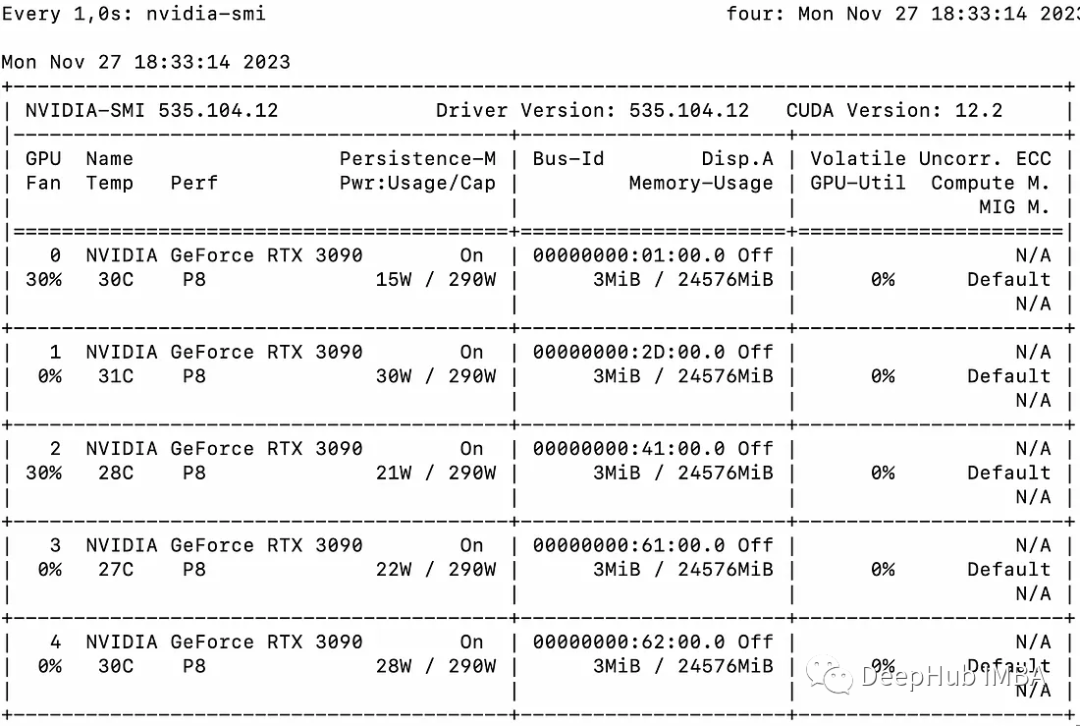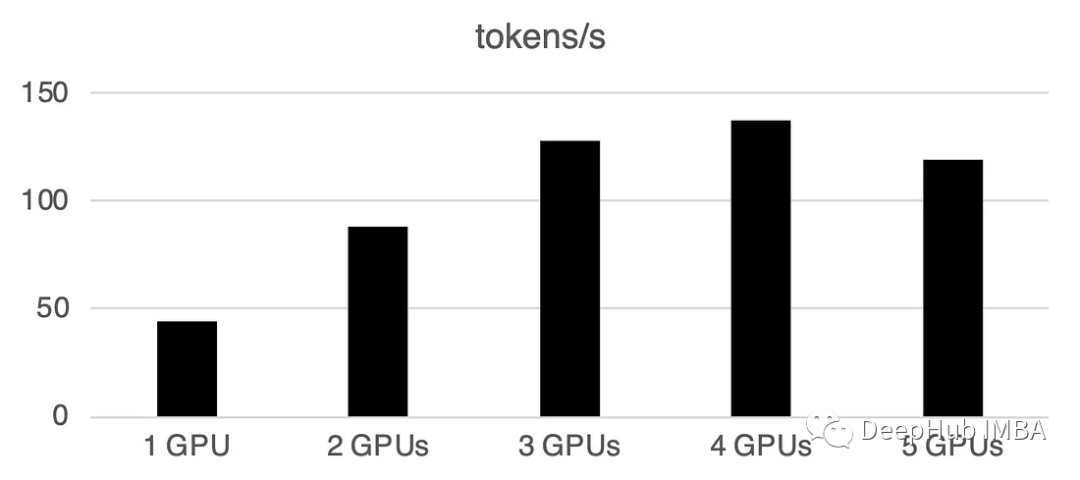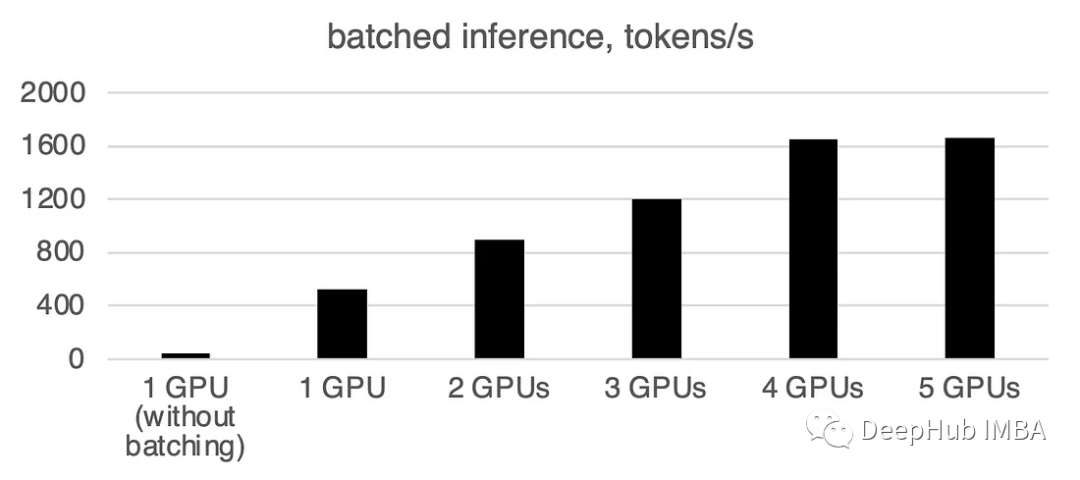大型语言模型(llm)已经彻底改变了自然语言处理领域。随着这些模型在规模和复杂性上的增长,推理的计算需求也显著增加。为了应对这一挑战利用多个gpu变得至关重要。

所以本文将在多个gpu上并行执行推理,主要包括:Accelerate库介绍,简单的方法与工作代码示例和使用多个gpu的性能基准测试。
本文将使用多个3090将llama2-7b的推理扩展在多个GPU上

基本示例
我们首先介绍一个简单的示例来演示使用Accelerate进行多gpu“消息传递”。
from accelerate import Acceleratorfrom accelerate.utils import gather_objectaccelerator = Accelerator()# each GPU creates a stringmessage=[ f"Hello this is GPU {accelerator.process_index}" ] # collect the messages from all GPUsmessages=gather_object(message)# output the messages only on the main process with accelerator.print() accelerator.print(messages)
输出如下:
['Hello this is GPU 0', 'Hello this is GPU 1', 'Hello this is GPU 2', 'Hello this is GPU 3', 'Hello this is GPU 4']
多GPU推理
下面是一个简单的、非批处理的推理方法。代码很简单,因为Accelerate库已经帮我们做了很多工作,我们直接使用就可以:
from accelerate import Acceleratorfrom accelerate.utils import gather_objectfrom transformers import AutoModelForCausalLM, AutoTokenizerfrom statistics import meanimport torch, time, jsonaccelerator = Accelerator()# 10*10 Prompts. Source: https://www.penguin.co.uk/articles/2022/04/best-first-lines-in-booksprompts_all=["The King is dead. Long live the Queen.","Once there were four children whose names were Peter, Susan, Edmund, and Lucy.","The story so far: in the beginning, the universe was created.","It was a bright cold day in April, and the clocks were striking thirteen.","It is a truth universally acknowledged, that a single man in possession of a good fortune, must be in want of a wife.","The sweat wis lashing oafay Sick Boy; he wis trembling.","124 was spiteful. Full of Baby's venom.","As Gregor Samsa awoke one morning from uneasy dreams he found himself transformed in his bed into a gigantic insect.","I write this sitting in the kitchen sink.","We were somewhere around Barstow on the edge of the desert when the drugs began to take hold.",] * 10# load a base model and tokenizermodel_path="models/llama2-7b"model = AutoModelForCausalLM.from_pretrained(model_path, device_map={"": accelerator.process_index},torch_dtype=torch.bfloat16,)tokenizer = AutoTokenizer.from_pretrained(model_path) # sync GPUs and start the timeraccelerator.wait_for_everyone()start=time.time()# divide the prompt list onto the available GPUs with accelerator.split_between_processes(prompts_all) as prompts:# store output of generations in dictresults=dict(outputs=[], num_tokens=0)# have each GPU do inference, prompt by promptfor prompt in prompts:prompt_tokenized=tokenizer(prompt, return_tensors="pt").to("cuda")output_tokenized = model.generate(**prompt_tokenized, max_new_tokens=100)[0]# remove prompt from output output_tokenized=output_tokenized[len(prompt_tokenized["input_ids"][0]):]# store outputs and number of tokens in result{}results["outputs"].append( tokenizer.decode(output_tokenized) )results["num_tokens"] += len(output_tokenized)results=[ results ] # transform to list, otherwise gather_object() will not collect correctly# collect results from all the GPUsresults_gathered=gather_object(results)if accelerator.is_main_process:timediff=time.time()-startnum_tokens=sum([r["num_tokens"] for r in results_gathered ])print(f"tokens/sec: {num_tokens//timediff}, time {timediff}, total tokens {num_tokens}, total prompts {len(prompts_all)}")
使用多个gpu会导致一些通信开销:性能在4个gpu时呈线性增长,然后在这种特定设置中趋于稳定。当然这里的性能取决于许多参数,如模型大小和量化、提示长度、生成的令牌数量和采样策略,所以我们只讨论一般的情况
1 GPU: 44个token /秒,时间:225.5s
2 gpu: 88个token /秒,时间:112.9s
3 gpu: 128个token /秒,时间:77.6s
4 gpu: 137个token /秒,时间:72.7s
5 gpu: 119个token /秒,时间:83.8s

在多GPU上进行批处理
现实世界中,我们可以使用批处理推理来加快速度。这会减少GPU之间的通讯,加快推理速度。我们只需要增加prepare_prompts函数将一批数据而不是单条数据输入到模型即可:
from accelerate import Acceleratorfrom accelerate.utils import gather_objectfrom transformers import AutoModelForCausalLM, AutoTokenizerfrom statistics import meanimport torch, time, jsonaccelerator = Accelerator()def write_pretty_json(file_path, data):import jsonwith open(file_path, "w") as write_file:json.dump(data, write_file, indent=4)# 10*10 Prompts. Source: https://www.penguin.co.uk/articles/2022/04/best-first-lines-in-booksprompts_all=["The King is dead. Long live the Queen.","Once there were four children whose names were Peter, Susan, Edmund, and Lucy.","The story so far: in the beginning, the universe was created.","It was a bright cold day in April, and the clocks were striking thirteen.","It is a truth universally acknowledged, that a single man in possession of a good fortune, must be in want of a wife.","The sweat wis lashing oafay Sick Boy; he wis trembling.","124 was spiteful. Full of Baby's venom.","As Gregor Samsa awoke one morning from uneasy dreams he found himself transformed in his bed into a gigantic insect.","I write this sitting in the kitchen sink.","We were somewhere around Barstow on the edge of the desert when the drugs began to take hold.",] * 10# load a base model and tokenizermodel_path="models/llama2-7b"model = AutoModelForCausalLM.from_pretrained(model_path, device_map={"": accelerator.process_index},torch_dtype=torch.bfloat16,)tokenizer = AutoTokenizer.from_pretrained(model_path) tokenizer.pad_token = tokenizer.eos_token# batch, left pad (for inference), and tokenizedef prepare_prompts(prompts, tokenizer, batch_size=16):batches=[prompts[i:i + batch_size] for i in range(0, len(prompts), batch_size)] batches_tok=[]tokenizer.padding_side="left" for prompt_batch in batches:batches_tok.append(tokenizer(prompt_batch, return_tensors="pt", padding='longest', truncation=False, pad_to_multiple_of=8,add_special_tokens=False).to("cuda") )tokenizer.padding_side="right"return batches_tok# sync GPUs and start the timeraccelerator.wait_for_everyone() start=time.time()# divide the prompt list onto the available GPUs with accelerator.split_between_processes(prompts_all) as prompts:results=dict(outputs=[], num_tokens=0)# have each GPU do inference in batchesprompt_batches=prepare_prompts(prompts, tokenizer, batch_size=16)for prompts_tokenized in prompt_batches:outputs_tokenized=model.generate(**prompts_tokenized, max_new_tokens=100)# remove prompt from gen. tokensoutputs_tokenized=[ tok_out[len(tok_in):] for tok_in, tok_out in zip(prompts_tokenized["input_ids"], outputs_tokenized) ] # count and decode gen. tokens num_tokens=sum([ len(t) for t in outputs_tokenized ])outputs=tokenizer.batch_decode(outputs_tokenized)# store in results{} to be gathered by accelerateresults["outputs"].extend(outputs)results["num_tokens"] += num_tokensresults=[ results ] # transform to list, otherwise gather_object() will not collect correctly# collect results from all the GPUsresults_gathered=gather_object(results)if accelerator.is_main_process:timediff=time.time()-startnum_tokens=sum([r["num_tokens"] for r in results_gathered ])print(f"tokens/sec: {num_tokens//timediff}, time elapsed: {timediff}, num_tokens {num_tokens}")
可以看到批处理会大大加快速度。
1 GPU: 520 token /sec,时间:19.2s
2 gpu: 900 token /sec,时间:11.1s
3 gpu: 1205个token /秒,时间:8.2s
4 gpu: 1655 token /sec,时间:6.0s
5 gpu: 1658 token /sec,时间:6.0s

总结
截止到本文为止,llama.cpp,ctransformer还不支持多GPU推理,好像llama.cpp在6月有个多GPU的merge,但是我没看到官方更新,所以这里暂时确定不支持多GPU。如果有小伙伴确认可以支持多GPU请留言。
huggingface的Accelerate包则为我们使用多GPU提供了一个很方便的选择,使用多个GPU推理可以显着提高性能,但gpu之间通信的开销随着gpu数量的增加而显著增加。
https://avoid.overfit.cn/post/8210f640cae0404a88fd1c9028c6aabb
作者:Geronimo
算子)



)







)

:树搜索给定结点的父亲(算法FindFather))




